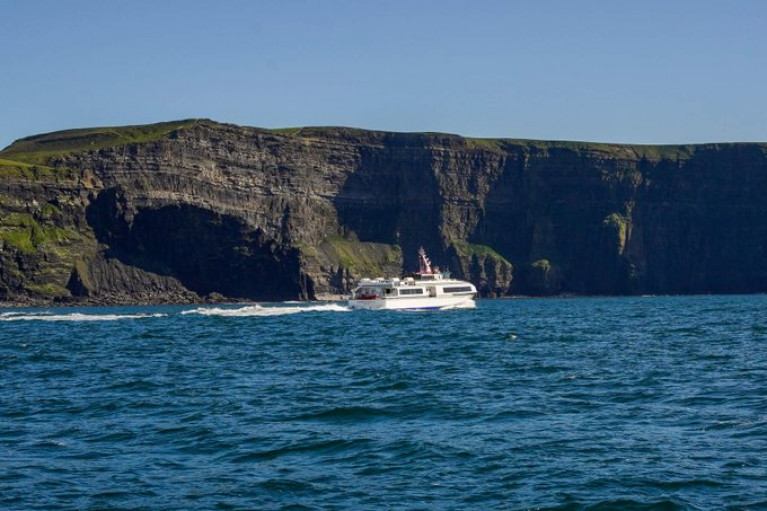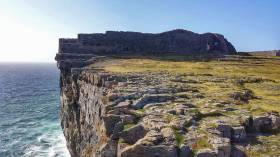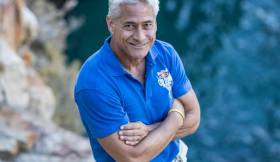Displaying items by tag: Inis Mor
Careful Now! Father Ted Festival Sells Out on Inis Mór
The Aran islands’ “TedFest” has sold out several months before it kicks off on Inis Mór in early March.
Organisers of the celebration of one of Ireland’s best-loved television shows advise people not to travel to Inis Mór unless they have already reserved accommodation.
The festival, initiated in 2007, was inspired by the Channel 4 sitcom, Father Ted, created by Graham Linehan and Arthur Mathews.
“Everything subject to change without notice nor comeback, whether due to acts of God or straightforward incompetence,” is the mantra for the event from March 2nd to 5th, when Inis Mór becomes “Craggy island” for the weekend.
 The Aran islands’ “TedFest” has sold out several months before it kicks off on Inis Mór in early March Photo: Adam Patterson
The Aran islands’ “TedFest” has sold out several months before it kicks off on Inis Mór in early March Photo: Adam Patterson
The organisers promise the “biggest ever TedFest”, involving “all the ecumenical craic”, with “copious cups of tea and sandwiches, a lot of red tank-tops, nuns on the run, priests on the pull, map-cap costumes and of course a bishop getting a kick up the arse”.
 All the ecumenical craic - Tedfest kicks off on Inis Mór in early March Photo: Adam Patterson
All the ecumenical craic - Tedfest kicks off on Inis Mór in early March Photo: Adam Patterson
Highlights include “the annual Lovely Girls Competition, Blind Date with Eoin McLove (Patrick McDonnell), King of the Sheep, Pat Mustard Lip SyncShowdown, The Craggy Cup, Ted's Got Talent, The Screeching Competition in a very Dark Cave and Matchmaking with Nellie”, they state.
 Nuns on the run is a feature of Tedfest 2023 in March on Inis Mór Photo: Adam Patterson
Nuns on the run is a feature of Tedfest 2023 in March on Inis Mór Photo: Adam Patterson
They also promise a “ Priests Dance Off, The Ghost Town Disco, The Craggy Comedy Craic Den, The Pan Asian Zen-Off, The Reverse Wheel of Death, the Father Ted Prizeless Quiz, Hide a Nun and Seek, and a finale on Sunday night titled 'We Made the BBC' with revellers dressed as their favourite BBC broadcasters”.
The website states, “please do not buy a ticket unless you have privately sourced accommodation or permission from another ticket holder to sleep with them”. The organisers say there is availability in Inis Mór’s glamping village.
Marina on Aran's Inis Mór One Step Closer with Brexit Funding
Development of a marina on the Aran island of Inis Mór is one step closer with Brexit-related funding approved by Minister for Marine Charlie McConalogue.
A sum of 475,000 euro has been granted for the provision of a floating pontoon berthing face at Cill Rónain pier on Inis Mór, being 95 per cent of the quoted cost of 0.5 million euros for the project.
The remaining five per cent must be provided by the local authority, as in Galway County Council.
Pontoons have already been developed for both sailors and inshore fishing vessels at Ros-a-Mhíl harbour in south Connemara which is main ferryport for the Aran islands.
Galway harbourmaster Capt Brian Sheridan said the pontoons would bring “improved access and safety for leisure sailors, and will drive economic gain” for businesses at Cill Rónain.
“It’s been a great week for everything marine in the west, “Capt Sheridan said, referring to the Port of Galway being brought under the umbrella of the TEN-T network, support from the European Investment Bank and the development of leisure pontoons at Cill Rónain.
The funding is part of the second tranche of the local authority marine infrastructure scheme (BALAMI) financed through the Brexit Adjustment Reserve (BAR) – the EU funds provided to Ireland to compensate for the impact of Britain’s withdrawal from the EU.
The second round involves 54 new projects in total around the Irish coast, and additional monies for 19 previously approved projects which had requested additional aid in light of cost increases.
The minister also raised the rate of funding provided for all projects to 95%.
It brings total funding for the BALAMI scheme to €55.3m for 164 projects around the Irish coast.
BAR funding must be drawn down by the end of 2023 or it will return to Brussels.
A seasonal gift from the Easter Bunny is for visitors to Galway this year, as Aran Island Ferries recommences its award winning cruise to Inis Mór and the Cliffs of Moher.
Last year saw the ferry company (added a new ferry) to its regular transport routes with a stunning day long, or even overnight trip to some of the most stunning locations in the west.
Setting off in the morning from Galway City, the tourist cruise of Galway Bay and beyond treats guests to the beautiful vistas of the west coast.
Awarded “Best Irish Experience 2021”, the cruise takes you to Inis Mór, the largest of the three Aran Island, to enjoy for several hours in the morning and afternoon.
The ferry will then return by way of the Cliffs of Moher, giving people a new way appreciate the staggering scale of Ireland’s most famous landmark, as the waterside wide truly puts the cliffs into perspective.
For further details of the ferry cruises, Galway Daily has more on the resumption of the service.
Aran Island of Inis Mór Moves Closer to Energy Autonomy
The Aran island of Inis Mór is moving closer to energy autonomy, with the installation of almost 240 solar panels on 20 buildings on the island.
The scheme is part of a European renewable energy project currently being implemented by Údarás na Gaeltachta and Comharchumann Forbartha Árann.
The EU Horizon 2020 programme is funding the four-year research project known as ReAct (Renewable Energy for self-sustAinable Island CommuniTies).
The State’s Gaeltacht development agency Údarás na Gaeltachta is a partner in association with Comharchumann Forbartha Árann, along with 23 other partners in 11 European countries.
The REACT project began in 2019 to research energy sustainability on offshore islands.
Inis Mór, Árainn is one of three pilot islands participating in the project along with San Pietro (Italy) and La Graciosa (Spain).
Phase two on Inis Mór has been completed, according to Údaras na Gaeltachta, which means that almost 240 solar panels have been installed on four public buildings, 13 dwellings and two commercial units.
“Using innovative renewable energy technology, it is hoped that this project will lower emissions and energy costs on this Gaeltacht island,” the Gaeltacht authority says.
“It is envisaged that when this pilot scheme is completed that Inis Mór will have the potential to prove that the Island could have energy autonomy not to mention the reduction in greenhouse gas emissions,” it says.
The technology installed recognises how each individual building uses energy by linking technology, weather forecasts and electricity tariffs, it says.
“The system stores energy in batteries and calculates the optimum time for efficient energy usage, taking the weather and electricity tariffs into consideration,” it says.
It pays tribute to the “pioneering work” of the island’s energy co-op Comharchumann Fuinnimh Árann and the main co-op, Comharchumann Forbartha Árann Teo.
Údarás na Gaeltachta is the chief project coordinator in Ireland and is working closely with Comharchumann Forbartha Árainn Teo, NUI Galway, ESBN, SEAI, Spain’s Orduna and Mitsubishi.
The ReAct project is being implemented as part of the strategic project An Ghaeltacht Ghlas (The Green Gaeltacht) which forms a core part of Údarás na Gaeltachta’s Strategic Plan 2021 – 2025, it says.
“This project will demonstrate how renewable energy projects can address climate change, reduce energy costs using innovative technologies and find stable energy sources for small Gaeltacht communities,” Údarás na Gaeltachta’s chief executive officer Mícheál Ó hÉanaigh said.
He referred to the outcome of the recent COP 26 conference in Glasgow demonstrating “the need to act now, not later”.
Such a project could have environmental and economic benefits by linking renewable energy and storage systems with technologies to enable an integrated and digitalised smart grid which could benefit homes in Árainn and along the west coast, he said.
More information is on https://react2020.eu/
Two Italian brothers rescued after they were knocked into the sea in the Aran Islands have returned to meet the coastguard crew who saved them.
In February 2019, Giovanni and Ricardo Zanon were struck by an unexpected wave at Poll na bPéist on Inis Mór, falling 20 metres off the cliff into the cold Atlantic.
Despite sustaining serious injury — Ricardo Zanon broke his tibia and pelvis in the fall — the brothers survived to tell the tale thanks to the swift actions of the crew of the Irish Coast Guard’s Shannon-based helicopter Rescue 115.
As previously reported on Afloat.ie, Rescue 115’s winchman Philip Wrenn won a prestigious award earlier this year for his role in the rescue.
The Zanon brothers and their parents returned to Inis Mór today (Wednesday 11 August) for the first time since the incident to give thanks to Wrenn and the rest of the crew.
Speaking to RTÉ’s Morning Ireland, Ricardo said of that fateful day: “I just remember a big, huge wave like a grey wall coming towards me and then it was completely dark and I thought I was going to die.”
RTÉ News has more on the story HERE.
Inis Mór Gets €166K for Road Resurfacing Works
The Connacht Tribune reports that Inis Mór in the Aran Islands will receive some €165,000 for road resurfacing works.
Bóthar Cill Mhuirbhigh gets the largest share — €90,000 — of the allocation from the Department for Rural & Community Development.
Works on the island’s ‘Low Road’ will receive €45,000, while Bóthar Iar Airne gets €31,000.
Galway Bay FM reports that residents on Inis Mór in the Aran Islands are appealing for tourists and other visitors to stay away for the next fortnight to limit the spread of COVID-19.
Comharchumann Forbartha Árann Teo issued a statement saying residents have overwhelmingly voted in favour of limiting travel to or from Inis Mór until Sunday 29 March.
In addition, islanders are asked to avoid travel to and from the mainland for the rest of this month’s containment period.
Cemetery Works On Inis Mór Among Coastal Protection Projects Funded By €750K Grant
Galway Bay FM reports that almost €100,000 has been ring-fenced for the completion of coastal protection works on Inis Mór in the Aran Islands.
The works will focus on arresting erosion at the island’s coastal cemetery, which locals fear will bear the brunt of more extreme weather in the future.
The funding comes from a grant of more than €750,000 from the Department of Culture, Heritage and the Gaeltacht to complete improvement works on a number of the Ireland’s coastal islands.
Besides Inis Mór, the list includes Whiddy Island, Bear Island, Hare Island and Sherkin Island in Co Cork; Inis Bigil, Clare Island and Inishturk in Co Mayo; and Oileán an Bhráighe, Árainn Mhór and Gabhla in Co Donegal.
#Skibbereen - TheJournal.ie reports that a 14-year-old boy is in critical condition after he was struck in the head by a boom while yachting off Skibbereen yesterday morning (Saturday 24 June).
The teenager was airlifted to Cork University Hospital by the Irish Coast Guard helicopter Rescue 117, and the latest news from Independent.ie is that his condition was improving.
Elsewhere yesterday, Howth Coast Guard attended a 53-year-old man with serious head injuries sustained while kitesurfing off Sutton in North Co Dublin.
And Shannon’s Rescue 115 was called to Inis Mór in the Aran Islands for the medevac of a woman who suffered spinal injuries while taking part in the Red Bull Cliff Diving World Series event.
Greg Louganis Set For Red Bull Cliff Diving On Inis Mór
#CliffDiving - World famous Olympic diver Greg Louganis will attend the Red Bull Cliff Diving World Series event in the Aran Islands later this month as the competition’s new sports director, as Galway Bay FM reports.
The five-time world champion and four-time Olympic gold medallist will arrive on the island of Inis Mór ahead of the globe’s cliff diving elite, who make their return to Poll na Péist — also known as the Serpent’s Lair — on the first stop of this year’s world tour, as previously reported on Afloat.ie.
All tickets for live spectators have been snapped up for the contest on Saturday 24 June, but the action will be livestreamed online via Red Bull TV.

































































